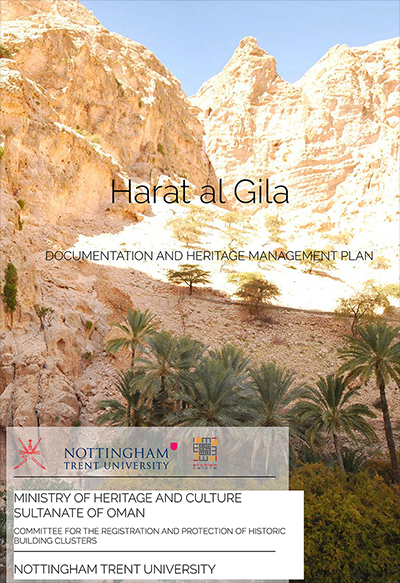Publications
Harat al-Gila: Documentation and Heritage Management and Development Plan
Bandyopadhyay, S., Quattrone, G., et al., 2014. Harat al-Gila: Documentation and Heritage Management and Development Plan.
Summary
This Documentation and Heritage Management Plan is concerned with the diminutive and difficult to reach mountain settlement of Harat al-Gila and its environs.The document builds upon the fieldwork documentation carried out on site in Autumn 2013, as well as on the interim field report submitted in February 2014.
Additionally a number of external sources were consulted, among which is a previous Heritage management plan by Chris Blandford and Associated (2008). Alongside providing comprehensive drawn documentation resulting from the survey carried out during fieldwork, this report includes a preliminary strategic Master Plan which addresses issues of heritage management, conservation and development, as well as approaches for its implementation.
The Master Plan illustrates zones and categories of development and conservation to be carried out, which builds on a statement of significance, and assessment of the state of conservation and the threats to heritage management at Sinaw, drawing on the experiences of researching and developing Master Plans for Hārat al-Yemen, Izkî (2011) and Hārat al-’Aqr, Bāhla WHS (2012) among others. The report also includes a comprehensive inventory of structural and non-structural defects present at the settlement as well as a study of the oasis context.
The Master Plan is informed by extensive documentation, analysis and interpretation of the urban structure, morphology, building typology and social conditions of the present and the immediate past. On this basis, a culturally and technically informed development plan is proposed, which advocates a sustainable revitalization centred on re-habitation, heritage tourism, education, training and skill development programmes with emphasis on traditional knowledge of the built environment and the crafts. As already suggested in previous submissions for Birkat al-Mawz, Fanja, Izkî, Ibri and Bahlā, here too the intention is to move away from an entirely tourism-focused development and towards a more sustainable alternative. Key zones are identified in the Master Plan for protection, restoration, rebuilding, consolidation and redevelopment.
Given the small settlement size and also its extremely important regional context, it was decided to have a wider focus to this document beyond the built characteristics of the hārah. The scope is therefore widened to include the surrounding wādi systems (Shaab and Tiwi) as well as the Shir Plateau and its numerous archaeological sites. The aim is to emphasise the need for studying natural settings and human habitation systems together at regional scale.

| Author(s) | Soumyen Bandyopadhyay Giamila Quattrone Martin Goffriller |
| Country | United Kingdom |
| Language | English |
| Subject | Documentation and Heritage Management |
| Area covered | Oman |
| Submission date | 2014 |
| Type | Report |
